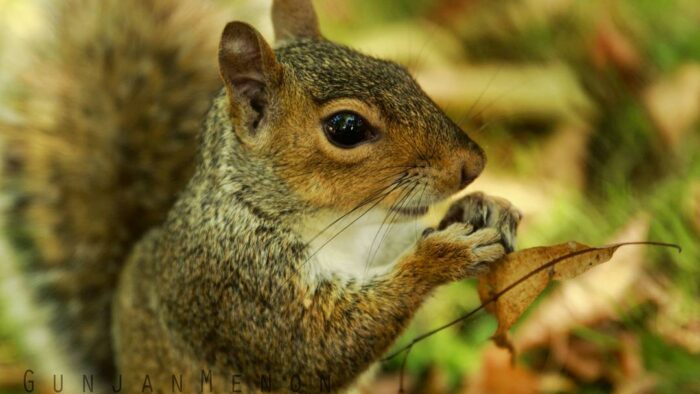An independent filmmaker, a globe trotter and a wildlife enthusiast, Gunjan Menon brings all her passions through stories and her camera. Having studied Wildlife Filmmaking from the University of the West of England, Bristol, she has always believed that “as a filmmaker, our stories have the power to change the world and it has been demonstrated time and again by conservation filmmakers across the world. I feel extremely privileged to be in a position that can influence the way people think and act.”
In this interview with CSP, Gunjan shares her love for wildlife, the journey of exploration and connecting with nature.
How has film making enabled you to infuse your interest in anthropology, an academic discipline, and wildlife conservation?
I fell in love with wildlife at the age of three after my grandfather gifted me a book about the amazon rainforest. As I grew up, my fascination and passion increased by watching natural history documentaries. However, I feel I grew up in a bubble. The natural world I so deeply admired was changing but the films I was watching weren’t telling the whole truth. This realisation pushed me towards telling stories of conservation instead of just showing pretty pictures. However, people don’t like being preached to and conservation stories aren’t effective if no one’s watching them so I decided to tap into my love for anthropology and combine it with wildlife conservation by sharing human interest conservation stories. I started making cross-genre films so I could bring conservation stories to the masses. To make films that can create tangible impact is perhaps the biggest motivation I have to work in this field.
Apart from films, how can digital channels be put to use for creating greater awareness and sensitivity towards co-existence between humans and nature?
With the rise of new digital platforms, it’s becoming easier to communicate with newer and younger audiences. There’s some exciting space for new forms of storytelling to engage people and help them find a connection with nature. If people can be made to fall in love with their backyard biodiversity, they’d be more willing to raise their voices when needed. Another great way is to utilise these mediums to empower people working on the frontlines of conservation. There are so many inspiring stories of heroes working tirelessly to protect our natural world which goes unnoticed by mainstream media. If people get to see more such stories, it might motivate them to join hands with them to amplify the grassroots movements.

Red Panda, Nepal
You have travelled across India, its neighbourhood and across the seas as well. What has been your most cherished memory and why?
I’ll cheat and tell you about two such experiences instead.
The first one was when I saw a red panda for the first time. It happened three years ago in the Eastern Himalayas of Nepal. The moment I first locked eyes with a panda cub was so powerful and life-changing that I’ve sort of made it my life goal to help these beautiful animals in whichever way I can. Even though my film is old now, I still take it to colleges and schools to teach students about red pandas and ways in which they can help them.
The second memory is from my trip to South Africa which made me realise conservation wasn’t as straightforward as I thought. I was invited as a speaker to Nature, Environment & Wildlife Filmmakers Congress in Durban, South Africa and after the conference, they took us on an excursion to Somkhanda Reserve. There I closely witnessed the dehorning of a rhino. The reason rhinos are targeted by poachers is for their horns, which for some absurd reason is valuable in the black market. It’s made up of keratin, the same protein found in our nails, hair and skin and yet, they are killed at an alarming rate due to this high demand. So, conservationists in South Africa have come up with an innovative way to protect them. Every 18 months, which is roughly the time it takes for the horn to regrow, they dehorn rhinos in the reserve so that there’s no reason left for the poachers to kill them. Dehorning is proving to be an effective anti-poaching tool when carried out properly and along with other holistic strategies in Africa. While the rhino did not feel any pain, it was one of the most painful experiences of my life. This majestic beast was lying in front of us, getting deformed by us, in an attempt to save it from our own kind. This was the only reason why rhinos were safe in the reserve but it made me wonder what have we as a species come to.

How can one understand diverse cultural practices and traditions through wildlife and nature?
If we approach wildlife and natural history stories more holistically, there’s so much to learn about diverse traditions and cultures. A shift in perspective is long overdue. We tend to look wildlife in isolation but if we shift our gaze to the people that live alongside them, there’s a lot that we can learn.
I’ve spent some time with communities that have a deep-rooted connection to nature and peacefully coexist with wildlife. For so many indigenous tribes and forest-dwelling communities, conservation is in their blood. We think of ‘sustainability’ as a choice but for them, it’s a way of life. They only take what they need from the forest and give back in so many ways. For instance, I recently filmed a story with the Raikas in Rajasthan, nomadic pastorals dependent on the forest for centuries. Their lives depend on the forest because of which, they are tolerant towards leopards they share their space with, despite the losses they face when it makes their goats or sheep its prey. The cultural tolerance they’ve afforded the leopards is deeply moving.
In Taplejung, a small village in Nepal, local communities have taken ownership of their forests and protect red pandas fiercely from poachers. Since the early ages, we humans have always had an innate need to connect with nature. Only recently in these past few decades, have we started moving away from this practice because of accelerated unsustainable development and overexploitation of resources. I’ve come to realise that we approach things quite differently. We always look at nature or the earth as entities that need to be saved or protected. However, it is we who need saving. Nature will always bounce back but if we can learn from these communities how to respect the natural world, we might make it through.
Where do you see the future of wildlife and conservation filmmaking heading towards in India? What more can be done to popularize this genre?
There’s a wave of upcoming filmmakers in India who have the common goal of using wildlife filmmaking as a tool for conservation. Our aim is no longer to just make a film that people watch, it’s to make impact-driven films which make people act. We’ve grown up with the digital medium and a lot of our viewers are content creators themselves with new digital platforms so they understand what goes into making stories. I honestly feel broadcasters in India have gotten it wrong. You cannot get more people to watch wildlife content just by filming same old stories and getting celebrities on board. People are tired of watching the same man drinking elephant piss. We need to make more personal, more passionate, authentic films, keeping a good story at the centre of everything.
As filmmakers, we need to be better aware, conscious, and ethical now more than ever before. That being said, the reason Indian documentaries fall behind in the international market is due to a lack of good funding within India. In my opinion, to popularize the genre, a multi-pronged approach is needed with better funding possibilities as well as simultaneous training opportunities for the next generation. Top it with a nudge towards more local content instead of investing more in acquiring international content, and maybe that’ll be a good start!
Gunjan Menon will be speaking on Filming the Wildlife, as a part of CSP 's upcoming festival, Srishti Sambhrama: Celebrating Earth Mother. Details of the event can be seen here.





